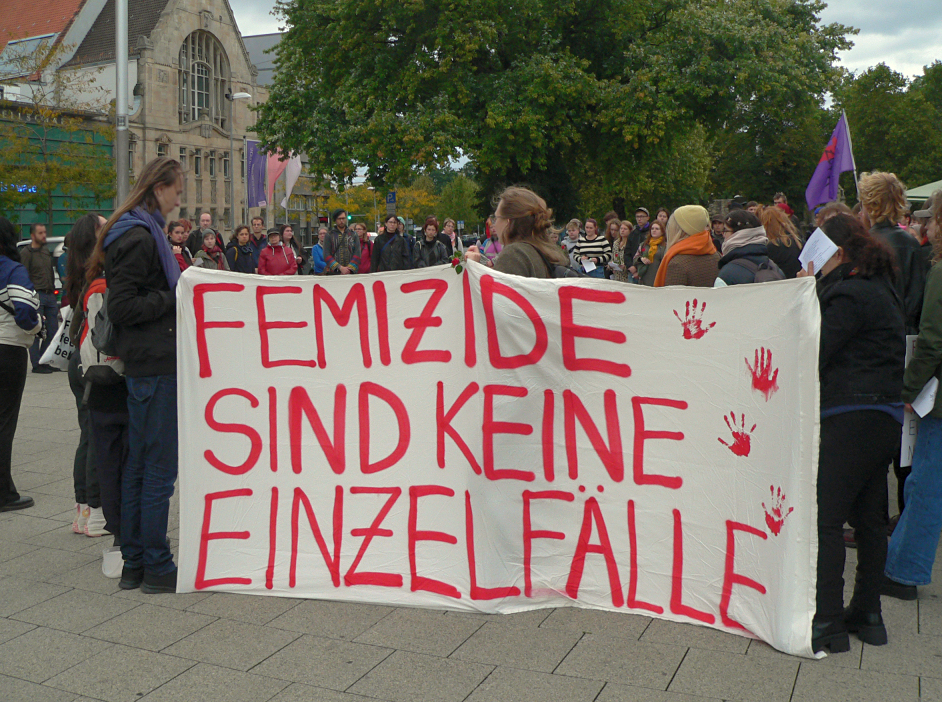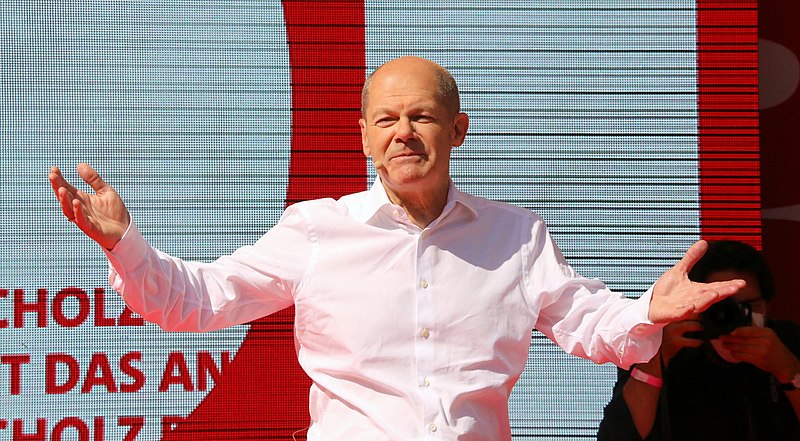This article originally appeared in Spanish in El Salto and was published before the recent election. Translation: Roser Gari Perez. Reproduced with permission.
Germany does not have a Ministry of Equality, or any specific law protecting women from gender-based violence. Moreover, murders related to gender-based violence are often not classified as murders, but as manslaughter — that is, as lacking “base motives” or malice.
A study published at the end of 2024 by the Bundeskriminalamt (German Federal Criminal Investigation Office/BKA) reveals the true extent of violence against women in the country. Experts and women’s organisations have called for the government — composed of the Social Democrats (SPD), the Liberals (FDP) and the Greens (Die Grünen), a coalition that presented a specific law against violence against women — to pass measures to address this violence. Germany will hold general elections in February 2025 without this proposal having gone ahead.
Manslaughter or murder?
In cases where women are murdered by their partners or ex-partners, there are two possibilities: either the perpetrators can be sentenced to life imprisonment for murder; or (as frequently happens) courts can classify these crimes as manslaughter, which carries a sentence of up to 15 years in prison. Often, judges consider the emotional state of the aggressor to be a mitigating factor, which results in lighter sentences.
Lawyer Leonie Steinl, chair of the Criminal Law Commission of the Deutscher Juristinnenbund (the German Association of Women Lawyers), has criticised the law in the Süddeutsche Zeitung for not guaranteeing more severe treatment in cases of feminicide, especially when they occur within a relationship, as established by the Istanbul Convention
According to Steinl, the legal system should allow for more severe penalties in these cases and establish that crimes committed in the context of a relationship (or former relationship) should be considered aggravating circumstances. This lack of rigour in the application of the law reflects, in her opinion, a deficiency in the judicial system that does not adequately address the seriousness of these crimes.
In addition, Steinl criticised a 2008 Bundesgerichtshof (Federal Court of Justice/BGH) ruling that excluded “morally reprehensible motivations” in cases of separation-related murder, arguing that the perpetrator acted out of the loss of something he did not want to let go of. For Steinl, this reasoning not only downplays the severity of the crime, but also reflects a patriarchal conception of the judicial system that should be revised.
Three women murdered every day in Germany
In 2023, Germany recorded 360 feminicides, which is equivalent to almost one woman murdered every day. Despite this alarming figure, the term “feminicide” lacks a specific legal definition, and crimes are dealt with under the offences of murder (Mord, punishable by life imprisonment) or involuntary homicide (Totschlag, with penalties of 5—15 years in prison). For a feminicide to be classified as Mord, the criteria of so-called “base motives” (niedrige Beweggründe) must be met — that is, the act must have a particularly despicable or immoral motive.
The lack of a clear and standardised definition of feminicide has resulted in many other homicides of women being left out of the official statistics. According to police data, 938 women were victims of homicide that same year.
Delal Atmaca, director of DaMigra, an organisation that brings together more than 60 immigrant women’s associations in Germany, warns that if there were a precise definition of feminicide, the total number of women murdered could be much higher — adding both feminicides and homicides together.
In total, Germany could reach an average of three women murdered per day. This reality emerges from a study published by the Bundeskriminalamt at the end of 2024, highlighting the true extent of violence against women in the country.
Despite their work, DaMigra face significant financial challenges, as budget cuts to the social and cultural sphere in Germany also affect their funding.
“We and other groups fighting against feminicide thought that the numbers would be much lower,” says Zora, a young women’s organisation that raises awareness of this issue. “It doesn’t surprise us, because although violence against women is increasing every year, funding for its prevention has suffered massive cuts. More and more shelters are closing and very few new ones are being built.”
Zora organises commemorative marches in front of the homes of the victims, placing candles and flowers as a sign of respect. In some communities, these actions generate reflection and support amongst neighbours, while in others, indifference or thoughtlessness predominate, although the latter is the minority case. In addition to these acts, the collective promotes political demonstrations to demand justice and concrete measures after each feminicide in Berlin.
Crime on the rise, and no Ministry of Equality
The study also reveals a worrying generalised increase in violence against women. There is a significant increase in rape, intimate partner violence and feminicide. Even political crimes motivated by misogyny are on the rise.
Despite these figures, activists at Zora lament society’s lack of reaction. “It didn’t make women take to the streets en masse on November 25,” they say, referring to the International Day for the Elimination of Violence against Women.
More than 52,000 girls and women were victims of rape, sexual harassment or coercion in 2023, 6.2% more than the previous year. Of these victims, half were under 18 years of age.
In the report, 68.6% of homicides are classified as domestic violence. This means that most girls and women are killed as a result of domestic violence (violence that occurs in the family environment) or violence from a partner. In the period covered by the report, in the year 2023, 180,715 women were victims of domestic violence — an increase of 5.6% compared to the previous year.
However, these figures only reflect cases reported to the police. The BKA warns that the real number is much higher, as many women do not report abuse.
The figures are scandalous, but perhaps the bigger picture is unsurprising, as Germany lacks a law to adequately protect women, or a Ministry of Equality. Gender policies fall under the remit of a ministry that covers several areas: the Ministry for Family Affairs, Senior Citizens, Women and Youth (BMFSFJ). According to Atmaca, this ministry has a traditionalist vision: “women are often considered only in the context of family and care work, rather than treating gender equality as an independent social objective. This contradicts the spirit of the Grundgesetz (Basic Law), which advocates active equality between women and men. The lack of attention to equality demonstrates how deeply rooted patriarchal structures and traditional gender roles are in politics and society.”
The current government, known as the traffic light coalition because of the colours of its parties (Green, Social Democrats in red and Liberals in yellow), presents itself as progressive, and one of its commitments was to implement the long-awaited Protection against Gender-Based Violence Act. However, the legislative process has been significantly delayed. After months of internal debate, they failed to agree on a joint project before the coalition splintered at the end of 2024. Subsequently, the SPD and the Greens independently presented a comprehensive bill on assistance against violence that was debated in parliament on 6 December. So far, it has not been passed.
The lack of a law protecting against gender violence
Michael Kretschmer, Vice President of the BKA, points out that the facts and figures demonstrate that violence and hatred towards women are growing social problems. He indicates that there is an increase in all kinds of crimes committed specifically against women. He also recognises that “there is a large dark field in this phenomenon”, which means that the real figures, especially in terms of domestic and digital violence, are likely to be much higher. Kretschmer emphasises that it is essential that the security authorities continue to monitor the evolution of these crimes, understand their root causes and act accordingly.
Although Germany complies with a key requirement of the Istanbul Convention — the collection and publication of data on gender-based violence — criticism of its implementation remains strong. DaMigra emphasises that although the treaty was ratified in 2018, Germany still lacks a specific law on protection against gender-based violence.
The organisation denounces this “unacceptable political stalemate”. Furthermore, they emphasise that — despite the Istanbul Convention and the increased awareness of the problem — there is still a lack of effective structures and measures to protect women, especially migrants and refugees, who remain amongst the most vulnerable.
The increase in violence in all its forms shows that current measures are insufficient. “It is our job to keep up the pressure, to demand political accountability and to promote profound social change,” says Delal Atmaca. “When a woman is murdered in this country, we must take to the streets and demand justice. But we must also point out the complicity of the German state, which bears responsibility for every one of the women murdered here,” conclude the Zora activists.

